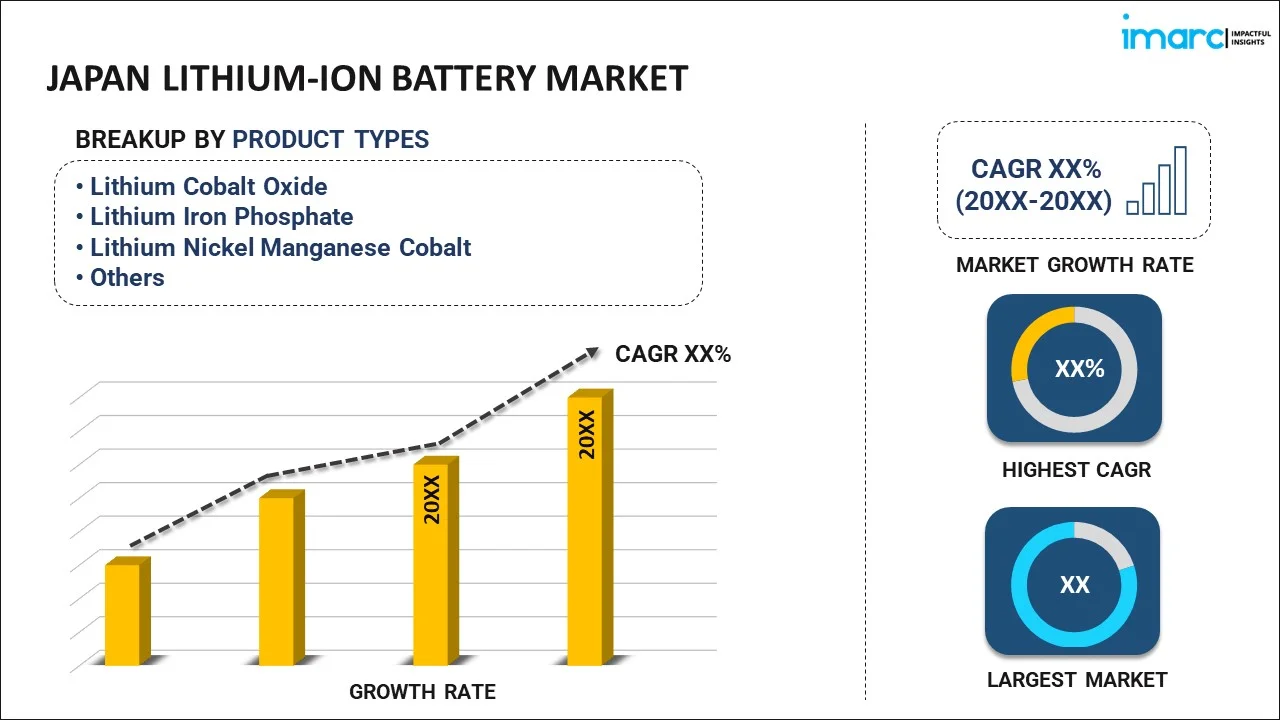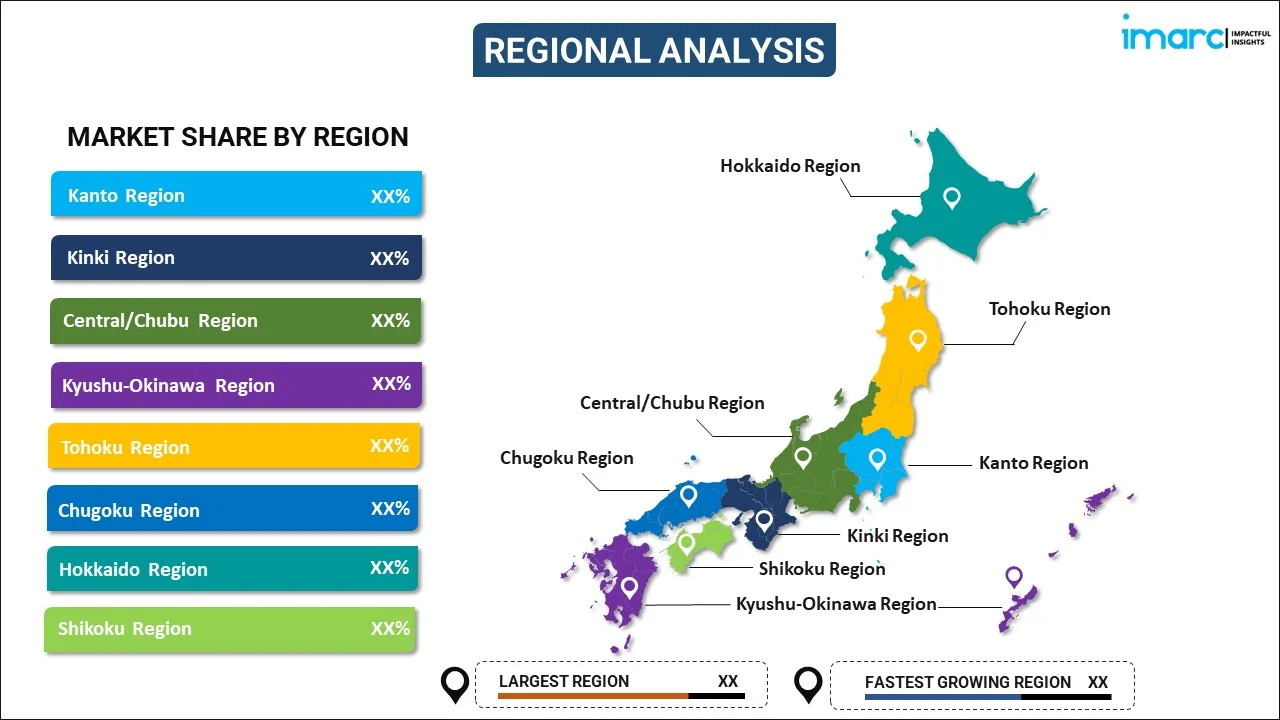
Japan Lithium-Ion Battery Market Report by Product Type (Lithium Cobalt Oxide, Lithium Iron Phosphate, Lithium Nickel Manganese Cobalt, Lithium Manganese Oxide, and Others), Power Capacity (0 to 3000mAH, 3000mAH to 10000mAH, 10000mAH to 60000mAH, More than 60000mAH), Application (Consumer Electronics, Electric Vehicles, Energy Storage, and Others), and Region 2025-2033
Market Overview:
The Japan lithium-ion battery market size reached USD 1.8 Billion in 2024. Looking forward, IMARC Group expects the market to reach USD 8.1 Billion by 2033, exhibiting a growth rate (CAGR) of 17.57% during 2025-2033. The augmenting demand for energy-efficient solutions due to the commitment for reducing carbon emissions, expanding usage of electric vehicles (EVs) and renewable energy systems, and the presence of several leading battery manufacturers and a well-established supply chain represent some of the key factors driving the market.
|
Report Attribute
|
Key Statistics
|
|---|---|
|
Base Year
|
2024 |
|
Forecast Years
|
2025-2033 |
|
Historical Years
|
2019-2024
|
| Market Size in 2024 | USD 1.8 Billion |
| Market Forecast in 2033 | USD 8.1 Billion |
| Market Growth Rate (2025-2033) | 17.57% |
A lithium-ion (Li-ion) battery is a type of rechargeable battery that relies on the movement of lithium ions between the positive and negative electrodes to generate an electric current. It is characterized by a high energy density, long lifespan, low self-discharge rate, and lightweight design, and are also known for their significant energy storage relative to their size. These batteries operate on the principle of lithium ions moving from the negative electrode (anode) to the positive electrode (cathode) during discharge, and in the reverse direction during charging, with the flow of ions between the electrodes generating an electric current. The typical properties of these batteries include a voltage range of 3.6 to 3.7 V per cell, a charging temperature range of 0 to 45 degrees Celsius, a discharging temperature range of -20 to 60 degrees Celsius. Some of the key advantages of Li-ion batteries include their versatility in various shapes and sizes to suit different applications, high energy efficiency of around 80-90%, minimal environmental impact compared to other battery types, and low maintenance requirements.
Japan Lithium-Ion Battery Market Trends:
The market in Japan is primarily driven by the augmenting demand for energy-efficient solutions due to the commitment for reducing carbon emissions. In line with this, the expanding usage of electric vehicles (EVs) and renewable energy systems that require these batteries are providing an impetus to the market. Also, the considerable rise in the integration of lithium-ion batteries into the broader energy ecosystem is creating a positive outlook for the market. Besides this, the increasing need for portable electronic devices such as smartphones and laptops due to a technologically savvy population is creating lucrative opportunities in the market. Moreover, the considerable investment in research and development (R&D) activities to enhance battery performance to facilitate resilience against natural disasters is also acting as a significant growth-inducing factor for the market. In addition to this, the presence of several leading battery manufacturers and a well-established supply chain is impacting the market positively. The market is further driven by government initiatives and regulatory support to promote clean energy solutions and sustainable practices. Apart from this, the strategic collaborations among industry players and academic institutions for developing measures to improve recycling and environmental practices are propelling the market. Furthermore, the augmenting demand for smart-grid projects and smart energy storage solutions due to the growing awareness and acceptance of clean energy technologies among consumers are intensifying the product demand. Some of the other factors contributing to the market include the growing international demand for Japanese technology, a strong focus on innovation and quality control, rising deployment of backup power systems, and favorable trade policies reinforcing Japan's position as a significant exporter of lithium-ion batteries.
Japan Lithium-Ion Battery Market Segmentation:
IMARC Group provides an analysis of the key trends in each segment of the Japan lithium-ion battery market report, along with forecasts at the country level for 2025-2033. Our report has categorized the market based on product type, power capacity and application.
Product Type Insights:

- Lithium Cobalt Oxide
- Lithium Iron Phosphate
- Lithium Nickel Manganese Cobalt
- Lithium Manganese Oxide
- Others
The report has provided a detailed breakup and analysis of the market based on the product type. This includes lithium cobalt oxide, lithium iron phosphate, lithium nickel manganese cobalt, lithium manganese oxide, and others.
Power Capacity Insights:
- 0 to 3000mAH
- 3000mAH to 10000mAH
- 10000mAH to 60000mAH
- More than 60000mAH
The report has provided a detailed breakup and analysis of the market based on the power capacity. This includes 0 to 3000mAH, 3000mAH to 10000mAH, 10000mAH to 60000mAH, and more than 60000mAH.
Application Insights:
- Consumer Electronics
- Electric Vehicles
- Energy Storage
- Others
A detailed breakup and analysis of the market based on the application has also been provided in the report. This includes consumer electronics, electric vehicles, energy storage, and others.
Regional Insights:

- Kanto Region
- Kinki Region
- Central/ Chubu Region
- Kyushu-Okinawa Region
- Tohoku Region
- Chugoku Region
- Hokkaido Region
- Shikoku Region
The report has also provided a comprehensive analysis of all the major regional markets, which include Kanto Region, Kinki Region, Central/ Chubu Region, Kyushu-Okinawa Region, Tohoku Region, Chugoku Region, Hokkaido Region, and Shikoku Region.
Competitive Landscape:
The report has also provided a comprehensive analysis of the competitive landscape in the market. Competitive analysis such as market structure, key player positioning, top winning strategies, competitive dashboard, and company evaluation quadrant has been covered in the report. Also, detailed profiles of all major companies have been provided.
Japan Lithium-Ion Battery Market Report Coverage:
| Report Features | Details |
|---|---|
| Base Year of the Analysis | 2024 |
| Historical Period | 2019-2024 |
| Forecast Period | 2025-2033 |
| Units | Billion USD |
| Scope of the Report | Exploration of Historical and Forecast Trends, Industry Catalysts and Challenges, Segment-Wise Historical and Predictive Market Assessment:
|
| Product Types Covered | Lithium Cobalt Oxide, Lithium Iron Phosphate, Lithium Nickel Manganese Cobalt, Lithium Manganese Oxide, Others |
| Power Capacities Covered | 0 to 3000mAH, 3000mAH to 10000mAH, 10000mAH to 60000mAH, More than 60000mAH |
| Applications Covered | Consumer Electronics, Electric Vehicles, Energy Storage, Others |
| Regions Covered | Kanto Region, Kinki Region, Central/ Chubu Region, Kyushu-Okinawa Region, Tohoku Region, Chugoku Region, Hokkaido Region, Shikoku Region |
| Customization Scope | 10% Free Customization |
| Post-Sale Analyst Support | 10-12 Weeks |
| Delivery Format | PDF and Excel through Email (We can also provide the editable version of the report in PPT/Word format on special request) |
Key Questions Answered in This Report:
- How has the Japan lithium-ion battery market performed so far and how will it perform in the coming years?
- What has been the impact of COVID-19 on the Japan lithium-ion battery market?
- What is the breakup of the Japan lithium-ion battery market on the basis of product type?
- What is the breakup of the Japan lithium-ion battery market on the basis of power capacity?
- What is the breakup of the Japan lithium-ion battery market on the basis of application?
- What are the various stages in the value chain of the Japan lithium-ion battery market?
- What are the key driving factors and challenges in the Japan lithium-ion battery market?
- What is the structure of the Japan lithium-ion battery market and who are the key players?
- What is the degree of competition in the Japan lithium-ion battery market?
Key Benefits for Stakeholders:
- IMARC’s report offers a comprehensive quantitative analysis of various market segments, historical and current market trends, market forecasts, and dynamics of the Japan lithium-ion battery market from 2019-2033.
- The research study provides the latest information on the market drivers, challenges, and opportunities in the Japan lithium-ion battery market.
- Porter's five forces analysis assist stakeholders in assessing the impact of new entrants, competitive rivalry, supplier power, buyer power, and the threat of substitution. It helps stakeholders to analyze the level of competition within the Japan lithium-ion battery industry and its attractiveness.
- Competitive landscape allows stakeholders to understand their competitive environment and provides an insight into the current positions of key players in the market.
Need more help?
- Speak to our experienced analysts for insights on the current market scenarios.
- Include additional segments and countries to customize the report as per your requirement.
- Gain an unparalleled competitive advantage in your domain by understanding how to utilize the report and positively impacting your operations and revenue.
- For further assistance, please connect with our analysts.
 Inquire Before Buying
Inquire Before Buying
 Speak to an Analyst
Speak to an Analyst
 Request Brochure
Request Brochure
 Request Customization
Request Customization




.webp)




.webp)












